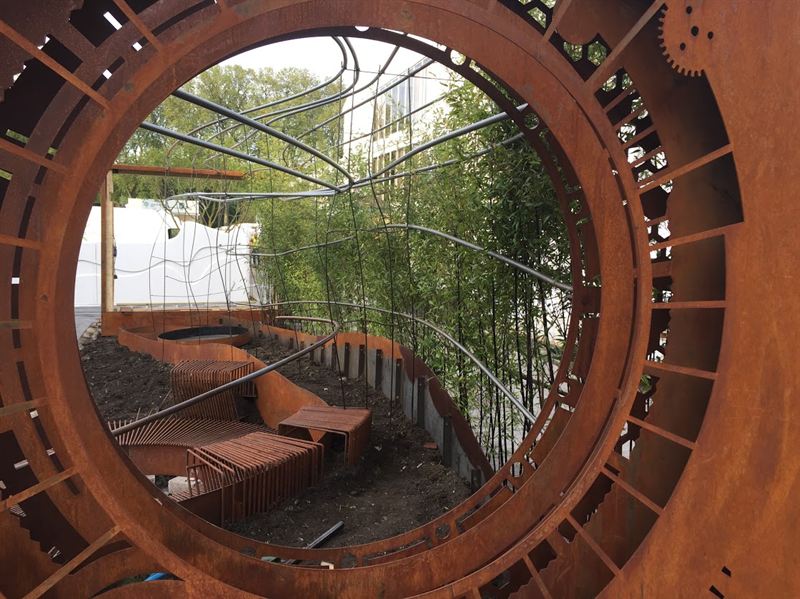Scientists to plant ‘Dark Matter’ at this year’s RHS Chelsea Flower Show

UK Astrophysicists have teamed up with horticulturalists, construction experts and an architect to create a garden for the 2015 RHS Chelsea Flower Show to help explain major workings of the Universe. Through innovative design and planting, the team, from Liverpool John Moores University’s National Schools’ Observatory (NSO) will be exploring ‘Dark Matter’ and its effect on light.
Sponsored by the Science and Technology Facilities Council, who fund UK involvement in Dark Matter research as well as the UK team at the Large Hadron Collider in CERN, the garden aims to excite and inspire everyone but particularly schoolchildren in the study of science through astronomy. The National Schools' Observatory (NSO) is a major educational website, established by the University, to allow schools to make their own observations alongside professional astronomers with the world's largest fully-robotic telescope - the Liverpool Telescope, operating at the international observatory site atop a mountain in the Canary Islands.
Professor Andy Newsam, Director of the National Schools’ Observatory explains:
“Dark matter is a hypothetical kind of matter that cannot be seen with telescopes but accounts for most of the matter in the universe. The existence and properties of dark matter are inferred from its gravitational effects on visible matter, radiation, and the large-scale structure of the universe.”
Understanding Dark Matter is essential since without it, the stars and galaxies around us, and even the Earth we stand on, would never have formed. It’s the big questions like this that make science exciting to new generations, including tomorrow’s scientists.
Chief designer of the garden, architect Howard Miller, explains the basis of the innovative design:
“A warped lattice of steel rods represents the bending trajectory of light around massive objects in the universe whilst invisible forces are simulated by the pulse and flow of grasses perpetually moving. The garden is bookended by a large circular opening, which symbolises the human view from telescopes on the ground into space.”
Lead horticulturalist Dori Miller adds:
“The planting is predominantly grasses such as Phyllostachys Vivas and Stipa tenuissima, chosen for their movement and sound qualities in the slightest breeze. These grassy matrices are spotted with highlights of colour in yellow, orange and rust, provided by flowering plants such as Ligularia and Bergenia.”
The garden is timed to celebrate the centenary of the publication of the General Theory of Relativity and also coincides with the European Year of Light.
Profesor Mike Bode, Professor of Astrophysics at LJMU's Astrophysics Research Institute, and a founder of the NSO, explains:
“Albert Einstein developed his General Theory of Relativity to help explain the fundamental workings of the Universe. Through this he also gave an accurate prediction of the way light can be bent by gravitational effects, and this is the basis of the method of detecting Dark Matter elucidated by the garden. However, today General Relativity is central to the workings of such everyday things as satnavs."
The 2015 RHS Chelsea Flower Show takes place from 19th to 23rd May 2015. ‘Dark Matter’ will be one of 15 featured in the ‘Fresh Gardens’ area.
Interviewees:
Professor Andy Newsam A.Newsam@ljmu.ac.uk 07590 480523
Professor Mike Bode m.bode@ljmu.ac.uk 07502 482523
They can be contacted throughout the build-up and the show itself and can put enquirers in direct contact with Howard Miller (designer), Dori Miller (horticulturalist) or David Binks (lead construction contractor) as required.
Times: available 8am-8pm and 8am-5pm on Saturday.
Date: Tuesday 19 - Saturday 23 May 2015 (Press Day, 18 May)
19 - 20 May RHS members only
21 - 23 May RHS members and non-members
Time: 19 - 22 May 8am-8pm
23 May 8am - 5.30pm (sell off starts at 4pm)
Venue: Royal Hospital, Chelsea, London
http://press.rhs.org.uk/RHS-Shows/Chelsea-2009.aspx
http://www.schoolsobservatory.org.uk/darkmatter
Designer: Howard Miller Design
Contractor: Landstruction Ltd
Image within release: The view through The Occulus showing how light from the distant universe is bent by the gravitational force of Dark Matter.
Images available to download:
Google Drive: https://drive.google.com/folderview?id=0BzqMRiAH9gqqfmthYjYtVHpGZ2QxcGM5cm51U0puWVpqYldFZndGaDE0LWJYaEN5Q1FoTVE&usp=sharing
http://www.astro.ljmu.ac.uk/~amn/Chelsea
Liverpool John Moores University (LJMU) has over 180 years’ experience educating students in a wide range of disciplines, spanning the arts, humanities, education, health, science and technology and we offer a diverse range of undergraduate degrees, postgraduate taught programmes and research opportunities. Over 95% of research submitted to the Research Excellence Framework (REF) in 2014 was of international quality or higher, with more than 70% of impact activity rated internationally excellent or world-leading. We are one of the top performing new universities in the UK for Architecture and Built Environment, Electrical and Electronic Engineering, General Engineering, Physics and Sports-Related Studies. LJMU also continues to be one of the UK’s leading higher education institutions for our interaction with business and the community. We are currently ranked in the top 40 UK universities for staff and graduate start-up companies and in the top 20 for spin-off companies.
Twitter : @LJMU
The Science and Technology Facilities Council (STFC) is keeping the UK at the forefront of international science and tackling some of the most significant challenges facing society such as meeting our future energy needs, monitoring and understanding climate change, and global security. The Council has a broad science portfolio and works with the academic and industrial communities to share its expertise in materials science, space and ground-based astronomy technologies, laser science, microelectronics, wafer scale manufacturing, particle and nuclear physics, alternative energy production, radio communications and radar. STFC operates or hosts world class experimental facilities including in the UK the ISIS pulsed neutron source, the Central Laser Facility, and LOFAR, and is also the majority shareholder in Diamond Light Source Ltd.
STFC enables UK researchers to access leading international science facilities by funding membership of international bodies including European Laboratory for Particle Physics (CERN), the Institut Laue Langevin (ILL), European Synchrotron Radiation Facility (ESRF) and the European Southern Observatory (ESO). STFC is one of seven publicly-funded research councils and is an independent, non-departmental public body of the Department for Business, Innovation and Skills (BIS).
Follow us on Twitter at @STFC_Matters



